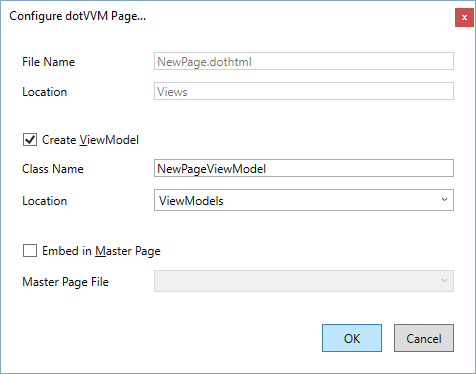Creating the First Page
Every page in DotVVM consists of a view and a viewmodel.
To create a page, just right-click the desired folder in the Solution Explorer window and choose Add / New Item.... In the dialog, navigate to the Web / DotVVM section and choose the DotVVM Page template.

After you enter the name of the page and confirm the selection, another window will appear. In this window, you can specify whether you want to create a viewmodel or not, and where it should be placed.

After you proceed, the view and the viewmodel are added to the project. If you place your view in the Views folder in your project, the window will automatically place your viewmodel in the ViewModels folder.
You don't have to follow this convention however. You can always create your own conventions, e.g. to have the views together with viewmodels in the same folder.
View
The view is a file with .dothtml extension. The views in DotVVM use standard HTML syntax with three flavors:
- Directives are placed at the top of the file. They define some page related information.
There is only one directive which is mandatory, and which must be present in each
.dothtmlfile:
@viewModel Namespace.ClassName, Assembly
- Data-binding Expressions allow to bind properties declared in the viewmodel to the specified place in UI, or to call commands on the viewmodel.
<p>Hi, my name is {{value: UserName}}!</p>
<p><img src="{value: ProfileImageUrl}" alt="Profile Image"/></p>
- DotVVM Controls are standard HTML elements with a namespace prefix. These prefixes are not registered using
the xmlns attributes like in XML-like languages. Instead, DotVVM looks in its configuration class (
DotvvmStartup) for registered namespaces, and looks for the controls in these namespaces. Each DotVVM control can specify several properties which are specified using attributes or child elements.
<dot:Repeater DataSource="..." style="display: none">
<ItemTemplate>
some content...
</ItemTemplate>
</dot:Repeater>
In the code sample above you can see the Repeater control. It has the DataSource property specified and an attribute
of the <dot:Repeater> element, and the ItemTemplate property which is specified inside the <dot:Repeater> element.
Whether the property is specified as an attribute, or as an child element, is defined by the developer of the control.
The DotVVM for Visual Studio extension supports IntelliSense and it will tell you which controls and properties are available.
If you want to apply any other HTML attribute to a control, you can do it on most of the controls. Notice the style attribute applied to the
Repeater control in our example. The most common use case for this is to add a class attribute to a DotVVM control.
ViewModel
The viewmodel is a plain C# class which is referenced in the .dothtml file using the @viewModel directive. Any .NET class can be the viewmodel, however there is one thing to remember:
The DotVVM viewmodel class must be JSON-serializable. To make everything work properly, we recommend to use only public properties and public methods.
Don't launch rockets in the space in your getters, setters and constructor(s) because they can be executed several times during the JSON serialization. If possible, don't put any logic in your getters and setters. You don't know in which order the serializer will set the values in the properties!
DotvvmViewModelBase
We recommend you to make your viewmodels derive from the DotVVM.Framework.ViewModel.DotvvmViewModelBase class. This class contains the Context property which will allow you to interact with the HTTP request, e.g. do a redirect to another page or route, access the configuration and much more.
The DotvvmViewModelBase class also declares the Init, Load and PreRender methods. You can override them to perform tasks in specific state of the HTTP request execution. You'll find more information about them in the ViewModels chapter.
If you cannot derive from the DotvvmViewModelBase class, you can implement the IDotvvmViewModel interface which declares the Context property too. DotVVM will make sure that you can access the HTTP request context using this property.